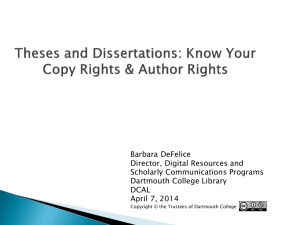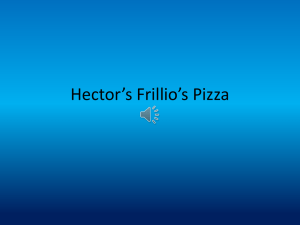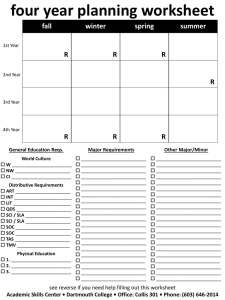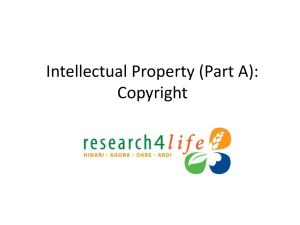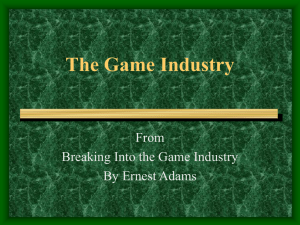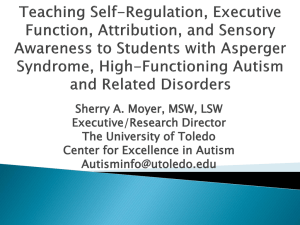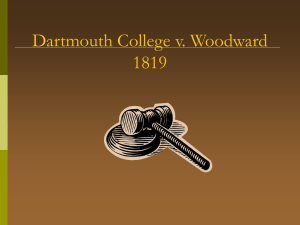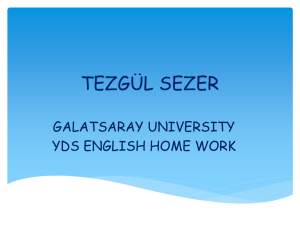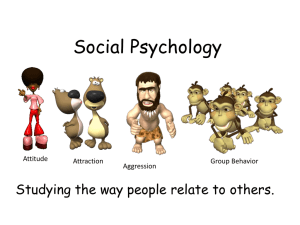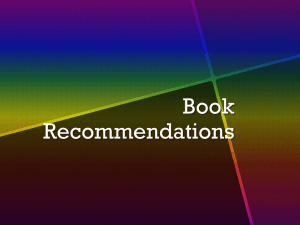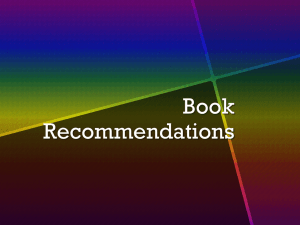Know Your Copy Rights
advertisement
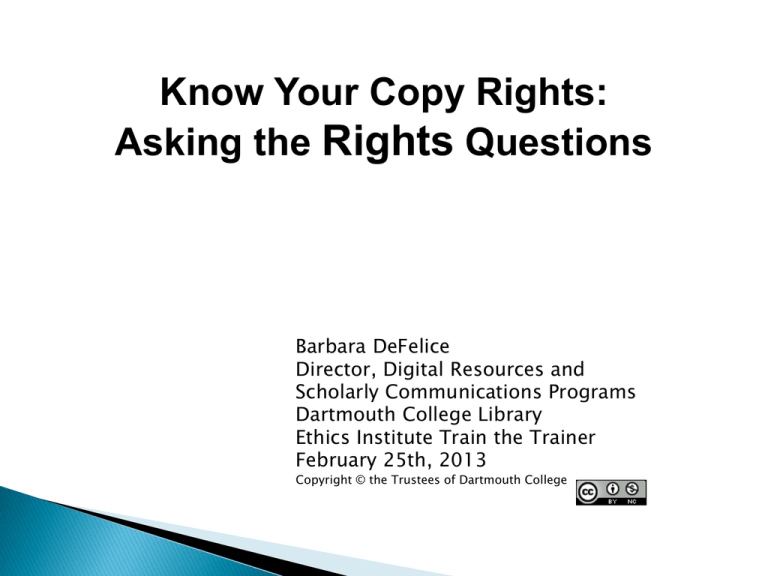
Know Your Copy Rights: Asking the Rights Questions Barbara DeFelice Director, Digital Resources and Scholarly Communications Programs Dartmouth College Library Ethics Institute Train the Trainer February 25th, 2013 Copyright © the Trustees of Dartmouth College What are Copy Rights? Who Owns Them? For How Long? When Do I Need to Get Permission to Use Copyrighted Work? What are Copy Rights? Copyright Law provides for a collection of rights that exist upon creation of a work in a tangible medium, which can be transferred or waived in whole or in part. These include: Distribute the work: publish, give away, sell Make copies, reformat, create derivative works Perform, display, and broadcast publicly "To promote the progress of science and useful arts, by securing for limited times to authors and inventors the exclusive right to their respective writings and discoveries." U.S. Constitution Article I, Section 8, Clause 8; 1787 (for 14 years after publication under the first copyright law of 1790) Who Owns Copy Rights? Dartmouth Copyright Ownership Policy Scholarly and creative works of Dartmouth faculty, students and staff are owned by the author or creator with these exceptions: •Assigned •Outside Tasks Agreements (OSP handles these) •Special Circumstances (shared copyright may be appropriate) •Patentable Works (for dissertations, can restrict the distribution date) “Did the use ”transform” the material ….by using it for a… different purpose from that of the original?” * Did the use “transform” the material by combining it with other materials to make a completely different work with a different purpose?” “Was the amount and nature of the material taken appropriate ….. in light of the nature of the work and of its use?”* *From the introductory material in the “Codes of Best Practices in Fair Use for….” Codes of Best Practices in Fair Use for.. ◦ 8 communities of practice now have these ◦ Documentary Film Makers, Poetry, Libraries, Open Educational Resources etc. ◦ Codify community practices in the context of the benefits accrued to society of accomplishing the intended work ◦ None have been challenged ◦ Creative, scholarly and educational endeavors supported a page or two from another person’s published journal article, book or report a section of a dissertation on my topic an image that I found on the Web a data set I obtained using DataThief or other such program this excellent graph that I found in another journal article lines from a poem art image from ArtSTOR or other proprietary collection portions (graph, text, image) of my already published work in my thesis or dissertation a data set I obtained using DataThief or other such program this excellent graph that I found in a journal article (for example from Nature or from an IEEE journal) data I found using a source like Knovel.com (digital handbooks with downloadable data sets) Figure 1.a. from: Interannual extremes in the rate of rise of atmospheric carbon dioxide since 1980 by C. D. Keeling, T. P. Whorf, M. Wahlen, J. van der Plichtt Nature 375, 666-670 (22 June 1995) Publisher: Nature Publishing Group Copyright © 1995, Nature Publishing Group Get permission to use this via the RightsLink Nature uses. Free of charge for use in a dissertation; for classroom use cost is $34.50 Creative Commons Attribution Share Alike License Copyrighted BUT no permission needed! Government information is in the Public Domain so NO permission needed! Example of an interactive Graph Digitizer from Knovel. “In Knovel's version, each of the design and mechanical property data tables is interactive. Knovel has digitally calibrated hundreds of graphs, such as the effect of temperature on various physical properties and stress-strain curves.” Military Handbook - MIL-HDBK-5H: Metallic Materials and Elements for Aerospace Vehicle Structures (Knovel Interactive Edition) Publisher: U.S. Department of Defense Copyright / Pub. Date: N/A Get permission from Knovel to use in a publication. Stakeholders: Copyright owner-the publisher; the authors of the paper, the data collectors and chart creators Pertinent copyright law: Who owns the rights to the article? To the image? To the graph? IF the graph you want is the key point of the article, even if it’s a small portion, get permission. Look at the two websites; one specifically states that it is available to use under a Creative Commons license and the other is a U.S. Federal government website and therefore in the public domain. So these can be used with attribution but do not require permission. 6 Creative Commons License Combinations Creative Commons Search Attribution (by) alone provides for all kinds of uses, including derivative works. Attribution Non-commercial (by-nc) provides for building upon and remixing but NOT for commercial purposes Attribution Share Alike (by-sa) allows building upon and remixing the work, even for commercial purposes. The users must license their work as Share Alike also. Attribution No Derivatives (by-nd) Attribution Non-commercial No Derivatives (by-nc-nd) is most restrictive Attribution Non-commercial Share Alike (by-nc-sa) provides for building upon and remixing but NOT for commercial purposes Stakeholders: Who are they in this case? Do the copyright owners-the publisher; the authors of the paper-own the data? What about the data collectors? Pertinent copyright law: Is it possible to copyright data? Who owns the rights to the data itself? Is using a program to extract data from a print graph any different than copying the data from the graph by hand into a spreadsheet for example? A graph, an image or some text from my already published journal article, poem, story or book. Remember that contract you signed? Get permission IF: You signed away ALL your rights to the publisher What you want to do is NOT in the rights you retained You cannot make a Fair Use case Publisher Policies on ”Author’s Pages” Links to copyright terms “Copyright Policy” How to get Permissions under “Rights & Permissions” Aggregated Publisher Copyright Policies & Self-Archiving Information SHERPA RoMEO http://www.sherpa.ac.uk/romeo/ Stakeholders: Copyright owner-the publisher in this case; the authors of the paper who want to reuse the material Pertinent copyright law: Who owns the rights to the article? Which rights? Exclusive rights? Since he or she does not own any rights to the article due to signing the publication contract which involves transferring all copy rights to the publisher, he or she needs to get the publisher’s permission to use his or her work in his or her dissertation or thesis OR he or she needs to greatly rework it so it is not the same material. Stakeholders: Student, faculty advisor, the institution because the institution has to follow the NIH mandate. Pertinent copyright law: Who owns the rights to the article used in the dissertation? Which rights? Exclusive rights? Who owns the right to the dissertation? She can use the Dartmouth Publication Amendment to retain the rights she wants. She needs to find the owner of the image to get permission or not use it. She must of course cite and attribute carefully. Even though UMI is making a digital copy of her dissertation and can sell copies of it, UMI has a NONexclusive commercial license, so that fact does not keep her from being able to publish this work in a journal. Review your contracts carefully and ask for help in determining what rights you will retain or want to retain Consider: what can you do with your material if you transfer all your copyrights to the publisher? Fair Use Checklist from Columbia U.S. Copyright Office Fair Use Copyright and Fair Use-list of cases from Stanford University Library ARL Code of Best Practices in Fair Use for Academic and Research Libraries Codes of Best Practices in Fair Use: Poetry, Media Literacy, Online Video Copy Rights and Author Rights Barbara DeFelice, Eliz Kirk & Jennifer Taxman Dartmouth Library Copyright Guidelines and Policies UMI Resources and Guidelines for Dartmouth College
